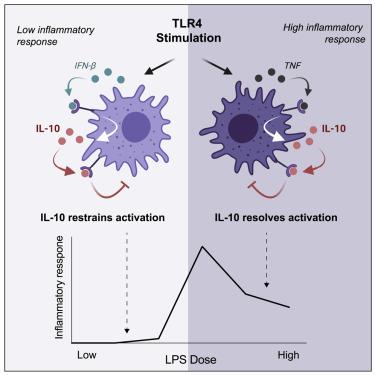Cell Reports ( IF 8.8 ) Pub Date : 2021-09-21 , DOI: 10.1016/j.celrep.2021.109728 Amanda F Alexander 1 , Ilana Kelsey 1 , Hannah Forbes 1 , Kathryn Miller-Jensen 2

|
Following Toll-like receptor 4 (TLR4) stimulation of macrophages, negative feedback mediated by the anti-inflammatory cytokine interleukin-10 (IL-10) limits the inflammatory response. However, extensive cell-to-cell variability in TLR4-stimulated cytokine secretion raises questions about how negative feedback is robustly implemented. To explore this, we characterize the TLR4-stimulated secretion program in primary murine macrophages using a single-cell microwell assay that enables evaluation of functional autocrine IL-10 signaling. High-dimensional analysis of single-cell data reveals three tiers of TLR4-induced proinflammatory activation based on levels of cytokine secretion. Surprisingly, while IL-10 inhibits TLR4-induced activation in the highest tier, it also contributes to the TLR4-induced activation threshold by regulating which cells transition from non-secreting to secreting states. This role for IL-10 in restraining TLR4 inflammatory activation is largely mediated by intermediate interferon (IFN)-β signaling, while TNF likely mediates response resolution by IL-10. Thus, cell-to-cell variability in cytokine regulatory motifs provides a means to tailor the TLR4-induced inflammatory response.
中文翻译:

单细胞分泌分析揭示了 IL-10 在抑制和解决 TLR4 诱导的炎症反应中的双重作用
在 Toll 样受体 4 (TLR4) 刺激巨噬细胞后,由抗炎细胞因子白细胞介素 10 (IL-10) 介导的负反馈限制了炎症反应。然而,TLR4 刺激的细胞因子分泌中广泛的细胞间变异性引发了关于如何有效实施负反馈的问题。为了探索这一点,我们使用能够评估功能性自分泌 IL-10 信号传导的单细胞微孔测定来表征原代鼠巨噬细胞中 TLR4 刺激的分泌程序。单细胞数据的高维分析揭示了基于细胞因子分泌水平的三层 TLR4 诱导的促炎激活。令人惊讶的是,虽然 IL-10 在最高级别抑制 TLR4 诱导的激活,它还通过调节哪些细胞从非分泌状态转变为分泌状态来促进 TLR4 诱导的激活阈值。IL-10 在抑制 TLR4 炎症激活中的这种作用主要由中间干扰素 (IFN)-β 信号传导介导,而 TNF 可能介导 IL-10 的反应消退。因此,细胞因子调节基序的细胞间变异性提供了一种调整 TLR4 诱导的炎症反应的方法。


























 京公网安备 11010802027423号
京公网安备 11010802027423号